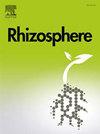Native entomopathogenic nematodes (Steinernematidae and Heterorhabditidae) provide effective biocontrol against Oriental leafworm moth, Spodoptera litura (Fabricius) (Lepidoptera: Noctuidae) in cabbage
IF 3.4
3区 生物学
Q1 PLANT SCIENCES
引用次数: 0
Abstract
The Oriental leafworm, Spodoptera litura, is a polyphagous pest that attacks several crops. In this study, we studied the susceptibility of the larval and pupal stages of S. litura to native entomopathogenic nematodes Heterorhabditis indica NBAIRH80, and S. surkhetense NBAIRS81. Bioassay results revealed that upon inoculating 400 infective juveniles (IJ) larva−1 to fourth-instar S. litura larvae with H. indica and S. surkhetense, H. indica caused 100% mortality whereas S. surkhetense caused 54% mortality. When S. litura pupae were inoculated with 50 IJ of H. indica, the pupal mortality was only 10% when the IJ concentration was increased to 600 IJ pupa−1, the pupal mortality also increased to 80%. The percentage mortality in larvae and pupae of S. litura increased significantly with increase in the exposure time. Both nematode species were able to penetrate into the S. litura larvae and also completed their life cycle by producing large numbers of IJ. Pot and field experiments showed that cabbage plants sprayed with H. indica and flubendiamide significantly reduced the number of larvae, leaf injury (H. indica: 0.7: 0–4 scale flubendiamide: 0.4: 0–4 scale), head injury (H. indica: 0.5: 0–4 scale flubendiamide: 0.6: 0–4 scale) and increasing yield (H. indica: 23.57 tonnes ha−1 flubendiamide: 25.53 tonnes ha−1). These results showed that, H. indica performed equally well that of flubendiamide. Overall results showed that H. indica NBAIRH80 can be incorporated in integrated pest management programme for S. litura.
本地昆虫病原线虫(Steinernematidae 和 Heterorhabditidae)对卷心菜中的东方卷叶蛾(Spodoptera litura (Fabricius))(鳞翅目:夜蛾科)具有有效的生物防治作用
东方叶虫(Spodoptera litura)是一种多食性害虫,可侵害多种作物。在这项研究中,我们研究了东方叶虫幼虫和蛹期对本地昆虫病原线虫 Heterorhabditis indica NBAIRH80 和 S. surkhetense NBAIRS81 的易感性。生物测定结果表明,将 400 头感染性幼虫(IJ)幼虫-1 接种到第四龄的 S. litura 幼虫上,H. indica 和 S. surkhetense 会导致 100%的幼虫死亡,而 S. surkhetense 会导致 54%的幼虫死亡。当 S. litura 蛹接种 50 IJ 的 H. indica 时,蛹的死亡率仅为 10%,当 IJ 浓度增加到 600 IJ pupa-1 时,蛹的死亡率也增加到 80%。随着暴露时间的增加,S. litura 幼虫和蛹的死亡率也显著增加。两种线虫都能穿透 S. litura 幼虫,并通过产生大量 IJ 完成其生命周期。盆栽和田间试验表明,白菜植株喷洒 H. indica 和氟苯蝶啶后,幼虫数量、叶片损伤(H. indica:0.7:0-4 刻度 氟苯蝶啶:0.4:0-4 刻度)、头部损伤(H. indica:0.5:0-4 刻度 氟苯蝶啶:0.6:0-4 刻度)显著减少,产量增加(H. indica:23.57 吨/公顷-1 氟苯蝶啶:25.53 吨/公顷-1)。这些结果表明,籼稻的表现与氟苯噻草胺相当。总体结果表明,可以将 H. indica NBAIRH80 纳入 S. litura 的虫害综合防治计划中。
本文章由计算机程序翻译,如有差异,请以英文原文为准。
求助全文
约1分钟内获得全文
求助全文
来源期刊

Rhizosphere
Agricultural and Biological Sciences-Agronomy and Crop Science
CiteScore
5.70
自引率
8.10%
发文量
155
审稿时长
29 days
期刊介绍:
Rhizosphere aims to advance the frontier of our understanding of plant-soil interactions. Rhizosphere is a multidisciplinary journal that publishes research on the interactions between plant roots, soil organisms, nutrients, and water. Except carbon fixation by photosynthesis, plants obtain all other elements primarily from soil through roots.
We are beginning to understand how communications at the rhizosphere, with soil organisms and other plant species, affect root exudates and nutrient uptake. This rapidly evolving subject utilizes molecular biology and genomic tools, food web or community structure manipulations, high performance liquid chromatography, isotopic analysis, diverse spectroscopic analytics, tomography and other microscopy, complex statistical and modeling tools.
 求助内容:
求助内容: 应助结果提醒方式:
应助结果提醒方式:


